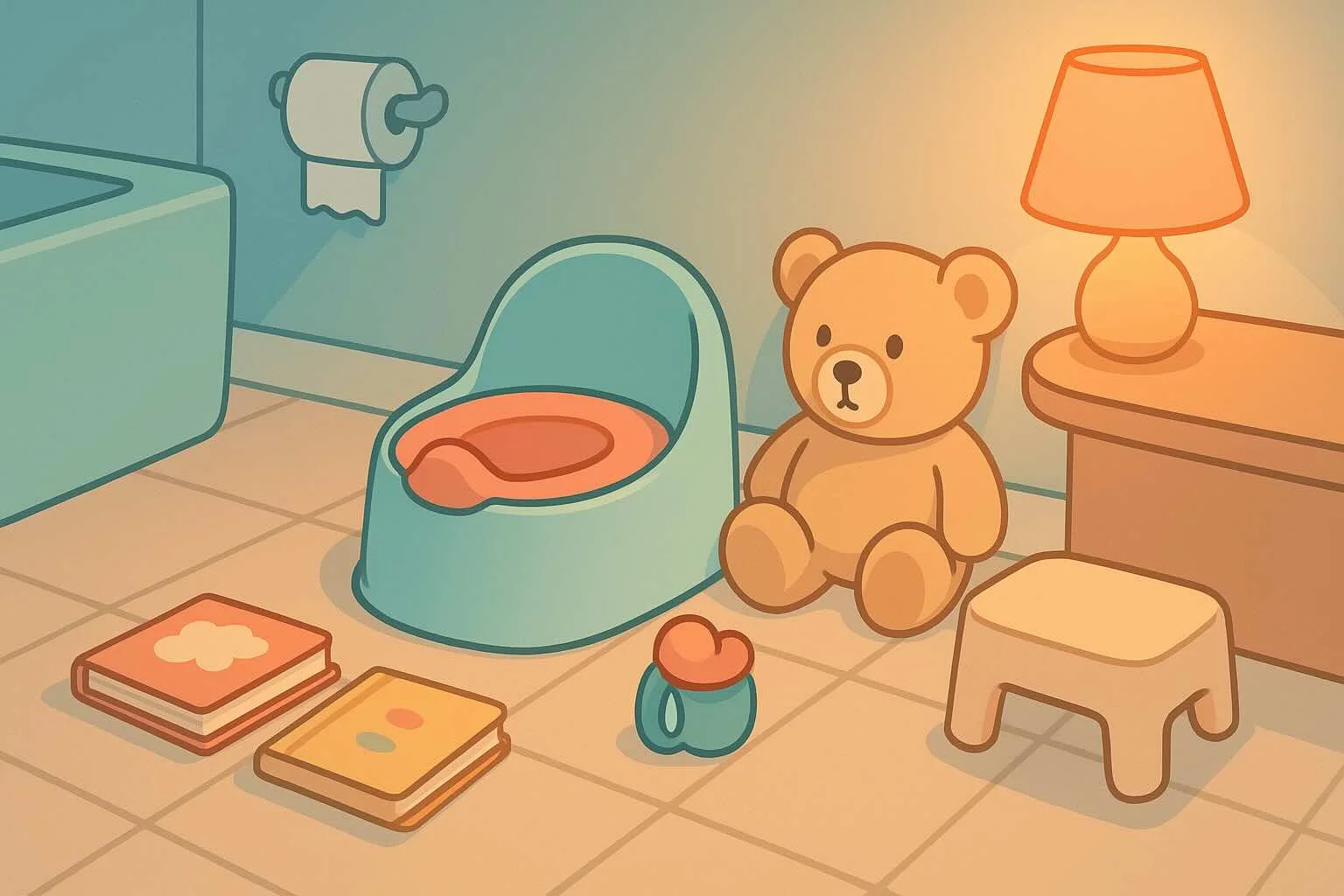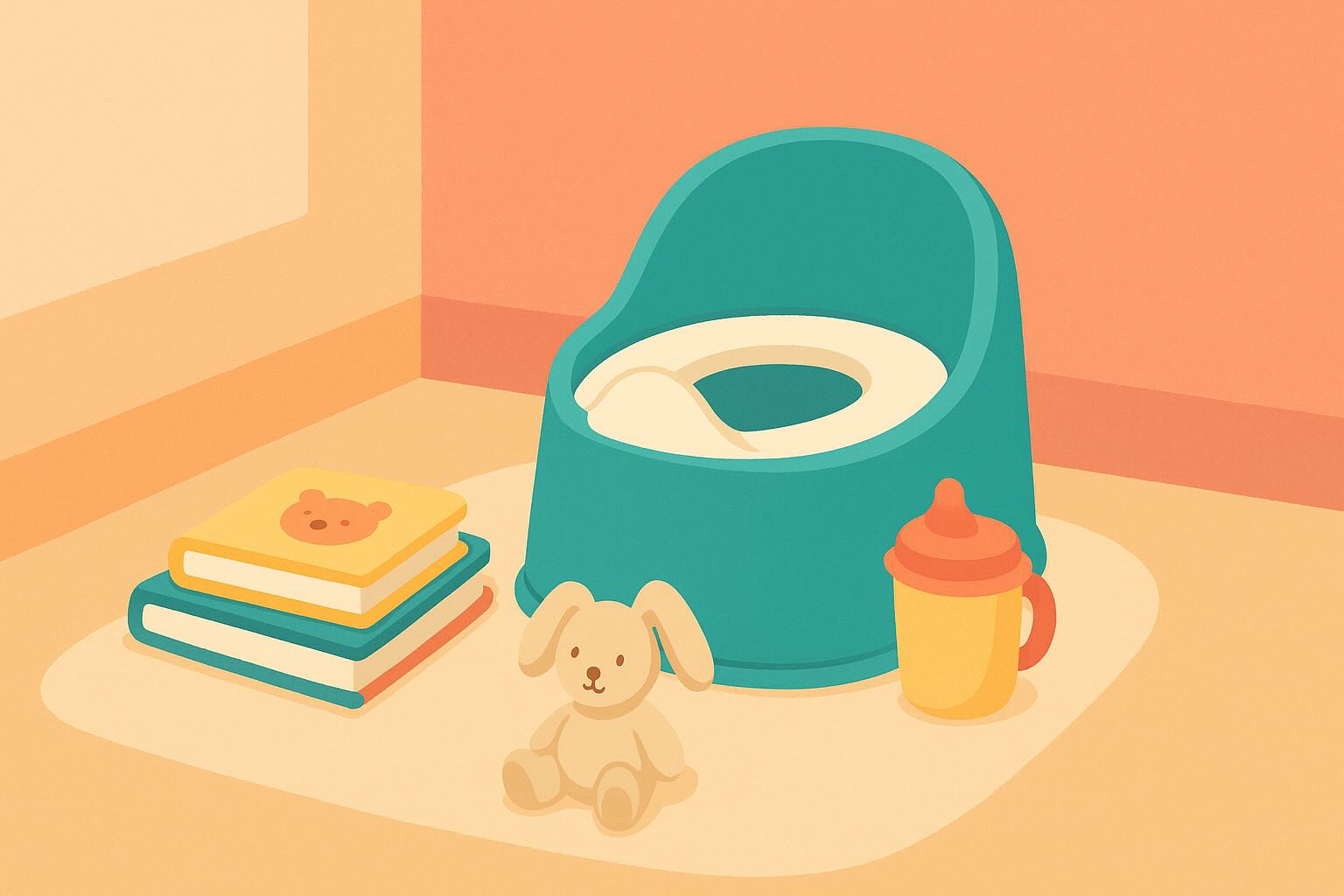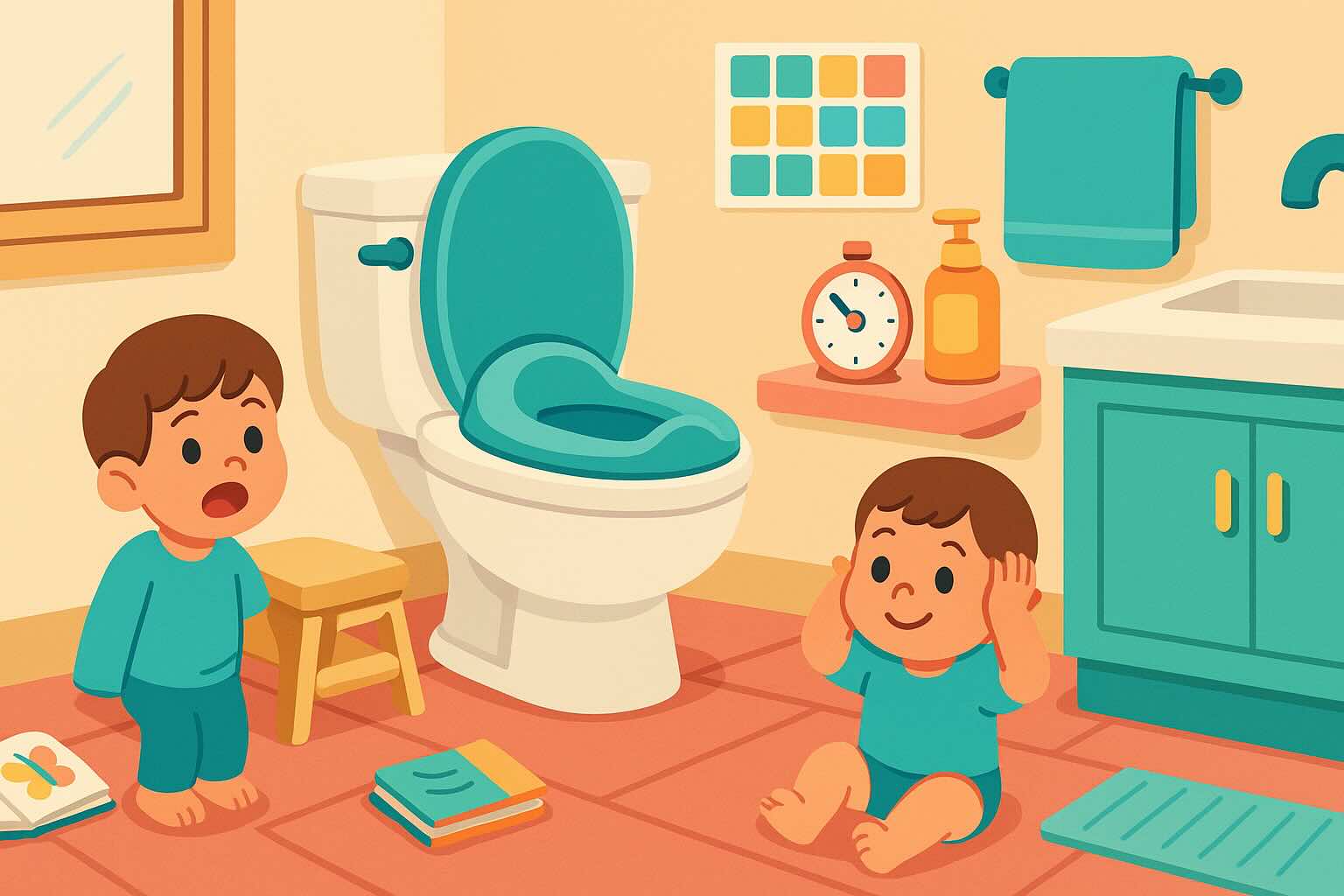Nighttime Potty Training: Why Biology Matters More Than Behavior
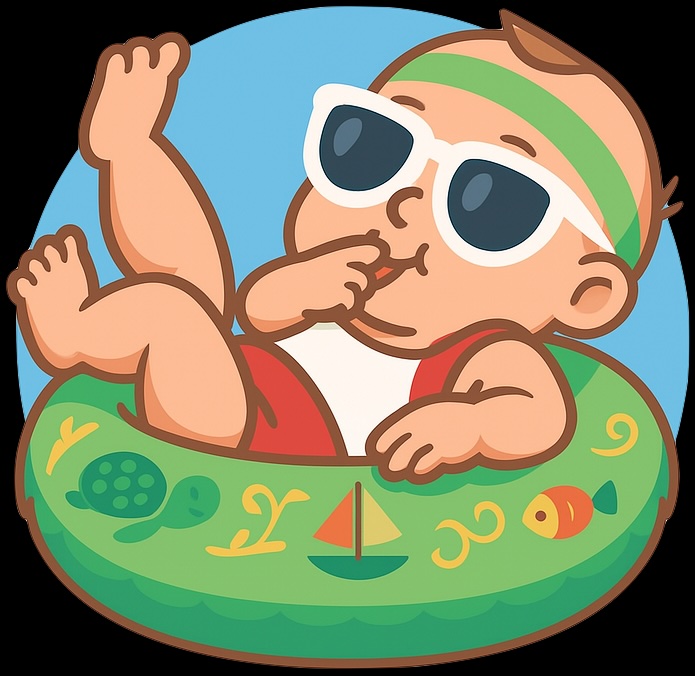
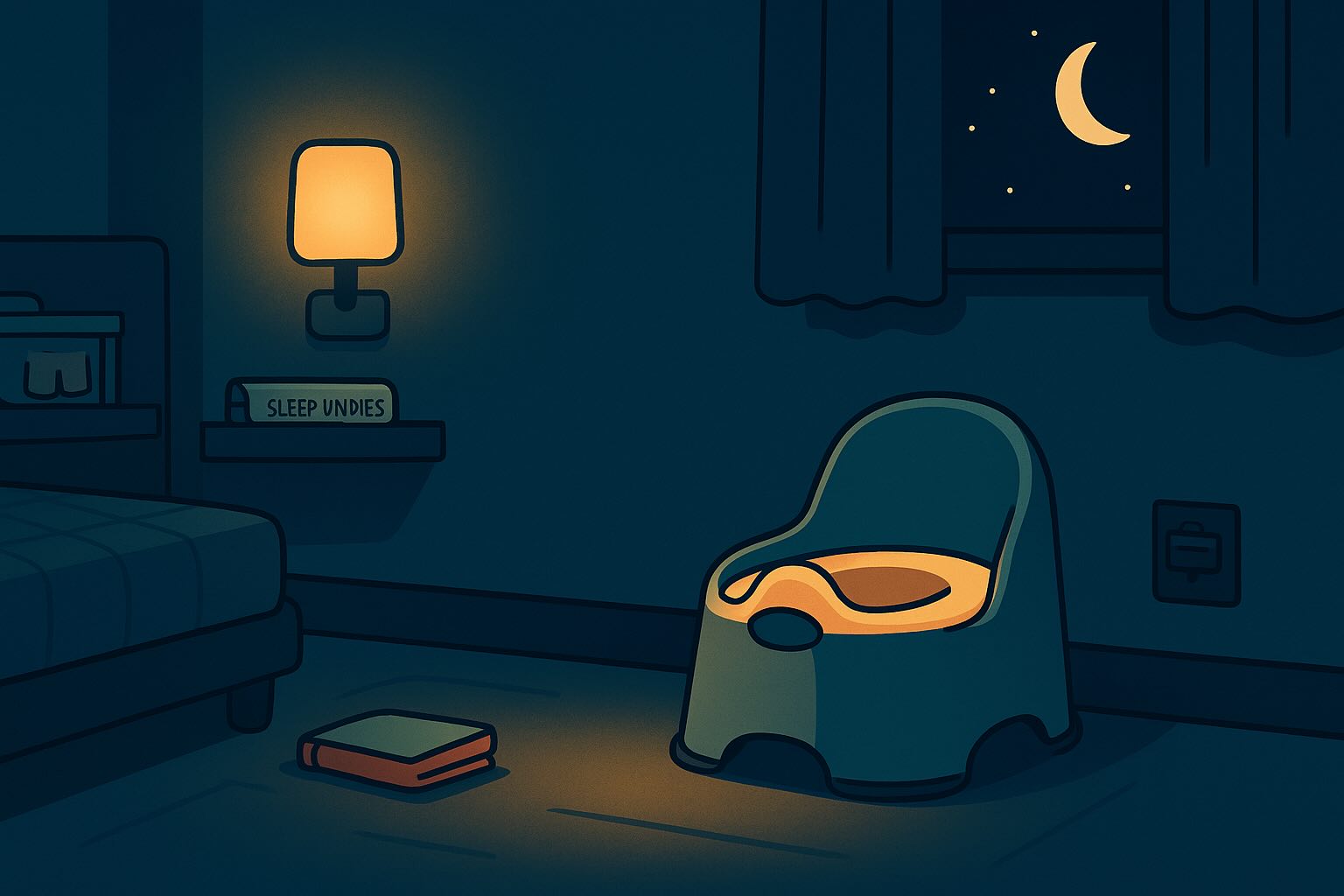
"My daughter has been potty trained for a year. During the day, she's perfect—never has accidents. But every single night, she wets the bed. I've tried everything: limiting drinks, waking her up at 11pm, rewards for dry nights. Nothing works. Is she just not trying? What am I doing wrong?"
You're not doing anything wrong. And your daughter IS trying (well, her body is trying).
Here's what you need to understand: Nighttime dryness is not something you train. It's something biology delivers when ready.
Nighttime potty training is possibly the biggest misnomer in parenting. You cannot "train" a child's body to produce the anti-diuretic hormone needed for nighttime dryness. You cannot "train" their bladder to grow larger capacity. You cannot "train" their sleeping brain to communicate effectively with their bladder.
All you can do is wait for biological readiness—and manage accidents with dignity and shame-free support in the meantime.
⚠️ Medical Disclaimer: This article provides educational information about nighttime dryness and bedwetting, not medical advice. Every child's biological development is unique. If you have concerns about your child's bedwetting, bladder function, health, or development, please consult your pediatrician for personalized medical guidance.
In this guide, you'll learn:
- Why nighttime dryness is biologically separate from daytime potty training
- The role of ADH hormone in nighttime dryness
- Timeline: when to expect nighttime dryness (hint: much later than you think)
- Signs that biology is approaching readiness
- Practical management strategies until readiness arrives
- When nighttime bedwetting needs medical evaluation
Let's start by understanding the biology that controls nighttime dryness.
The Biology of Nighttime Dryness: Why It's Different From Daytime
Daytime potty control requires:
- Conscious awareness of bladder signals
- Decision-making: "I need to go to the bathroom"
- Motor skills: Walking to bathroom, removing clothing
- Voluntary muscle control: Holding pee until positioned on potty, then releasing
These are behavioral skills you can teach and practice.
Nighttime dryness requires:
- ADH hormone production: Anti-diuretic hormone must increase at night to concentrate urine and reduce volume produced
- Bladder maturation: Bladder must be large enough to hold entire night's worth of urine (8-12 hours)
- Brain-bladder communication during sleep: Brain must either wake the child when bladder is full OR send signals to bladder to stay relaxed until morning
These are biological developments that happen on their own timeline.
The ADH Hormone: The Missing Piece
What ADH does:
- Produced by the pituitary gland
- Signals kidneys to reabsorb water and concentrate urine
- In adults and older children with nighttime dryness: ADH levels rise at night, producing less, more concentrated urine
In young children (and some older children with bedwetting):
- ADH production doesn't increase sufficiently at night
- Kidneys continue producing same volume of urine as during day
- Bladder fills faster than it can hold for 8-12 hours
- Result: Bladder reaches capacity during sleep → wetting occurs
You cannot "train" the pituitary gland to produce more ADH at night. This develops when the body is ready, typically between ages 4-7, sometimes later.
Bladder Capacity Development
Toddler/preschooler bladder:
- Small capacity (holds 3-5 oz)
- Needs frequent emptying (every 1-3 hours)
School-age bladder:
- Larger capacity (holds 8-12 oz by age 7)
- Can hold for longer periods (4-6 hours)
During sleep: Even a larger bladder needs to hold urine for 8-12 hours—which is why ADH hormone (concentrating urine) is essential.
You cannot "train" a bladder to grow faster. Size increases naturally with age and physical development.
The Deep Sleeper Factor
Some children are very deep sleepers—their sleeping brain doesn't register bladder signals that would wake them.
Brain-bladder communication develops over time:
- Some children's brains learn to wake them when bladder is full
- Other children's brains learn to send "stay relaxed" signals to bladder until morning
- Both are valid pathways to nighttime dryness
You cannot "train" sleep depth or brain-bladder signals. These develop as neurology matures.
Bottom line: Nighttime dryness requires biological maturation in multiple systems. Behavioral interventions (rewards, punishment, shame, pressure) have zero effect on biological timelines.
For more on child sleep patterns, see our sleep and bedtime guide.
Timeline: When Do Children Actually Achieve Nighttime Dryness?
Cultural expectation: "Potty trained by age 3" (implies both day and night)
Biological reality: Nighttime dryness happens much later for most children.
The Research on Nighttime Dryness
By age 5:
- 80-85% of children are dry at night
- 15-20% still wet the bed regularly
By age 7:
- 90% are dry at night
- 10% still experience bedwetting
By age 10:
- 95% are dry
- 5% still have nighttime accidents
By age 15:
- 98-99% are dry
- 1-2% still have bedwetting
Translation: If your 4, 5, or even 6-year-old wets the bed regularly, they are part of a large, normal group of children whose biology hasn't matured for nighttime dryness yet.
Factors That Affect Timeline
1. Genetics (strongest predictor)
- If one parent was a late bed-wetter, child has 40% chance of late dryness
- If both parents were late bed-wetters, child has 70% chance
2. Gender
- Girls typically achieve nighttime dryness 6-12 months earlier than boys on average
- Individual variation is huge
3. Sleep depth
- Deep sleepers take longer (brain doesn't wake to bladder signals)
4. Bladder capacity
- Children with smaller bladders take longer
5. ADH production
- Some children's pituitary glands mature later
What does NOT affect timeline:
- ❌ Parental pressure or training efforts
- ❌ Rewards or punishment
- ❌ Child's motivation or "trying harder"
- ❌ Limiting fluids before bed (has minimal to no effect on biological readiness)
Signs of Biological Readiness (When You Can TRY Removing Night Protection)
Important: These signs indicate readiness to TRY. If accidents continue, return to protection without shame—biology isn't ready yet.
The Primary Sign: Waking Up Dry
What to look for:
- Child wakes with dry diaper/pull-up 3-5+ mornings per week
- Pattern is consistent for 2+ weeks
- Not just one or two flukes
Why this matters: This is direct evidence that biology is maturing—either ADH is increasing (less urine produced overnight) OR bladder capacity is sufficient OR brain is managing bladder during sleep.
If this sign is NOT present: Your child is not biologically ready. Do not attempt nighttime training.
Supporting Signs
Large daytime bladder capacity:
- Can hold pee for 3-4 hours between bathroom trips
- Produces large volume when they do pee
Waking to use bathroom:
- Child wakes on their own during night to pee (rare but strong sign)
Dry naps (if still napping):
- Consistently wakes from naps dry
Age and family pattern:
- Approaching age 5-6
- Parents achieved nighttime dryness around this age
If you see the primary sign (waking dry) plus 1-2 supporting signs: You can try removing overnight protection. But be prepared to return to it if accidents continue.
Practical Nighttime Management: Shame-Free Strategies
While you wait for biological readiness (which could be months or years), here's how to manage nighttime wetting with dignity and minimal stress.
Use Overnight Protection Without Shame
Choose: Pull-ups, overnight diapers, or specialized bedwetting underwear (like GoodNites)
Frame it positively:
"Your body is still working on nighttime dryness. Pull-ups keep you comfortable and dry while you sleep. When your body is ready for nighttime dryness, we'll know because you'll wake up dry."
NOT: "You're still in pull-ups because you haven't tried hard enough to stay dry."
Avoid shame language:
- ❌ "You're too old for diapers"
- ❌ "Babies wear pull-ups"
- ❌ "When are you going to grow up and stay dry?"
Yes, affirming language:
- ✅ "Bodies learn nighttime dryness at different times"
- ✅ "This keeps you comfortable while you sleep"
- ✅ "Your body will tell us when it's ready"
Bedroom Setup for Easy Management
Waterproof protection:
- Waterproof mattress cover (essential—under the fitted sheet)
- Waterproof pad on TOP of fitted sheet (for quick changes without full bed strip)
- Layering technique: waterproof pad → sheet → waterproof pad → sheet (peel off top layer, dry sheet underneath)
Accessible supplies:
- Spare pajamas in bedside drawer
- Extra pull-ups/underwear nearby
- Laundry hamper in room or nearby bathroom
- Night light for safe nighttime navigation
Involve child in setup:
- "Where should we keep spare pajamas so you can find them easily if you need them?"
- Gives sense of control and problem-solving ownership
Morning Routine: No-Shame Accident Response
If child wakes wet:
Step 1: Matter-of-fact acknowledgment
"You were asleep and pee came out. That's okay. Your body is still learning nighttime dryness."
Step 2: Involve in cleanup
- "Can you put your wet pull-up in the trash?"
- "Can you put wet pajamas/sheets in the hamper?"
- "Let's get you cleaned up and in fresh clothes."
Step 3: Biological reassurance
"Nighttime dryness happens when your body makes a special hormone and your bladder grows big enough to hold all the pee overnight. Everyone's body does this at different times. Yours will do it when it's ready."
Step 4: Move on
- No lecture, no "remember next time," no disappointment
- Return to normal morning routine
What NOT to Do (Common But Harmful Approaches)
❌ Limiting fluids drastically
- May cause mild dehydration
- Doesn't address root biological cause
- Creates anxiety around drinking
- Moderate approach (stop 30-60 min before bed) is okay, but extreme restriction is not
❌ Waking child to pee (lifting)
- Interrupts sleep cycles
- Doesn't teach bladder control (child is asleep)
- May prevent development of natural wake signals
- Can create dependence on external intervention
❌ Rewards for dry nights
- Creates shame for wet nights (child has zero control)
- Implies wetting is a choice (it's not)
- Increases anxiety and pressure
❌ Punishment or consequences
- Traumatizing and damaging to relationship
- Zero effect on biological maturation
- Creates shame, anxiety, and potential hiding of accidents
❌ Comparing to siblings or peers
- Undermines self-esteem
- Creates shame and inadequacy
- Ignores biological reality of individual timelines
When to Try Removing Overnight Protection
Only when: Child is waking dry 3-5+ mornings per week consistently for 2+ weeks.
How to approach:
Step 1: Discuss with child
"I've noticed you're waking up with a dry pull-up most mornings! That means your body might be ready for nighttime dryness. Would you like to try sleeping in underwear, or would you rather keep using pull-ups until you're waking dry every morning?"
Honor their preference. If they want to keep protection, that's okay.
Step 2: Prepare for accidents
- Waterproof mattress protection in place
- Spare pajamas/sheets accessible
- Agreement: "If you wake up wet, it's no big deal. We'll just clean up and maybe go back to pull-ups for a while longer."
Step 3: Try for 1-2 weeks
- Track wet vs. dry nights
- Stay completely shame-free
Step 4: Assess
If 5+ dry nights out of 7: Continue! Biology is ready.
If 3+ wet nights out of 7: Return to pull-ups without shame.
"Your body is still working on nighttime dryness. Let's use pull-ups again until you're waking dry even more often. That's completely okay."
No disappointment, no pressure, no "try harder next time."
When to Seek Medical Evaluation
Medical consultation recommended if:
Age 7+ with no improvement
- Child is 7 years old and still wetting bed regularly
- No pattern of improvement or increasing dry nights
- Evaluation can identify any underlying issues
Secondary enuresis (regression)
- Child was dry at night for 6+ months
- Suddenly starts wetting regularly again
- May indicate: medical issue (UTI, diabetes, constipation), stress, trauma, sleep disorder
Daytime wetting too
- Both day and night accidents after age 5-6
- May indicate bladder dysfunction or other medical issue
Accompanying symptoms:
- Painful urination
- Extremely frequent urination
- Extreme thirst and drinking
- Loud snoring or sleep apnea symptoms
- Chronic constipation
Extreme distress
- Child is significantly affected emotionally
- Refuses sleepovers, school trips due to fear
- Shame is impacting self-esteem and daily functioning
Medical Evaluation May Include:
- Urine test (rule out infection, diabetes)
- Physical exam (check for constipation, anatomical issues)
- Family history assessment
- Sleep evaluation (sleep apnea can contribute to bedwetting)
Treatment Options (Typically Not Before Age 7-8):
Bedwetting alarm:
- Wakes child when moisture detected
- Trains brain-bladder communication
- Success rate: 60-70% with consistent use over 3-6 months
Medication (desmopressin):
- Synthetic ADH hormone
- Reduces urine production overnight
- Used short-term for specific events (camp, sleepovers) or longer-term in some cases
Addressing underlying issues:
- Treating constipation (can contribute to bedwetting)
- Managing sleep apnea
- Behavioral therapy for anxiety/trauma if relevant
The Bottom Line on Nighttime Dryness
Nighttime dryness is not a training issue. It's a biology issue.
Your child is not:
- Being lazy
- Not trying hard enough
- Regressing or failing
Your child's body is:
- Developing ADH hormone production on its own timeline
- Growing bladder capacity naturally
- Building brain-bladder communication through neurological maturation
These processes cannot be accelerated through:
- Pressure
- Punishment
- Rewards
- Shame
- Limiting fluids
- Waking them up
What you CAN do:
- Wait for biological readiness (waking dry most mornings)
- Use protection shame-free until readiness arrives
- Respond to accidents with neutrality and compassion
- Protect your child from shame (internal and external)
- Seek medical evaluation if needed (age 7+ with no progress, or earlier with concerning symptoms)
Most children achieve nighttime dryness between ages 4-7. Some take longer. The range is wide and completely normal.
Your job isn't to make your child's body mature faster.
Your job is to support them with patience, protect them from shame, and trust that their biology will deliver nighttime dryness when ready.
And when that day comes—when they wake up dry for weeks on end—it won't be because you trained them.
It will be because their body was ready. On their timeline. In their own perfect way.
Related Resources
- Potty Learning Complete Guide - Comprehensive overview of the entire potty learning journey
- 2 Year Old Potty Training Guide - Daytime readiness focus for toddlers
- 4 Year Old Not Potty Trained - Extended nighttime timeline support
- Potty Training Regression Guide - Handling nighttime regression
- Potty Training Accidents Guide - Responding to nighttime accidents
- Potty Training Travel Guide - Managing nighttime away from home
Complete Potty Learning Toolkit
Readiness assessments, age-specific strategies, and practical scripts to support your child's potty learning journey.
Need personalized support?
RootWise's AI coach can provide tailored strategies for your specific situation, available 24/7 when you need it most.
Learn More About AI Coaching →